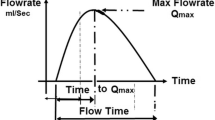Abstract
Introduction
We investigated the possibility that patients could carry out a urine flow assessment at home by themselves, in comfort, without expense and without the use of equipment. We compared this strategy of “Do-It-Yourself” (DIY) uroflowmetry with traditional, hospital uroflowmetry.
Materials and methods
One hundred and twenty patients were enrolled. The patients underwent conventional, free uroflowmetry in hospital. Subsequently, the patients were asked to carry out the following procedure at home: urinate into a graduated container to quantify the total voided volume and determine the flow time by measuring the duration of miction with a stopwatch or simply with the second hand of a clock. This procedure had to be performed three times without preparation.
Results
Hundred patients completed the study. The mean age of the patients analysed was 64.12 years. Their free uroflowmetry values were as follows: the mean voiding time was 44.28 s, the mean voided volume was 290.92 ml, the mean Qmax was 15.17 ml/s, the mean Qmean was 7.87 ml/s, and the mean post-void residual volume was 78.44 ml. The mean Qmean measured by the “DIY-uroflowmetry” was 8.33 ml/s, which was not statistically significantly different (P = 0.12). Assuming that pathological hospital uroflowmetry values are equivalent to a DIY-Qmean ≤10 ml/s and that normal hospital values are equivalent to a DIY-Qmean >10 ml/s, the concordance was 100 %.
Conclusions
Our proposed DIY evaluation of urine flow, together with the International Prostatic Symptom Score (IPSS), provides a good estimate of the results of free uroflowmetry, enabling unnecessary hospital investigations to be avoided.


Similar content being viewed by others
References
Berry SJ, Coffey DS, Walsh PC et al (1984) The development of human benign prostatic hyperplasia with age. J Urol 132:474–479
Madersbacher S, Alivizatos G, Nordling J et al (2004) EAU 2004 guidelines on assessment, therapy and follow-up of men with lower urinary tract symptoms suggestive of benign prostatic obstruction (BPH guidelines). Eur Urol 46:547–554
Abrams P, Feneley R, Torrens M (1989) Urodinamica. Mercalli Editore, Italia
Netto NR, de Lima ML, Netto MR et al (1999) Evaluation of patients with bladder outlet obstruction and mild international prostate symptom score followed up by watchful waiting. Urology 53:314–316
Wasson JH, Reda DJ, Bruskewitz RC et al (1995) A comparison of transurethral surgery with watchful waiting for moderate symptoms of benign prostatic hyperplasia. The Veterans Affairs Cooperative Study Group on transurethral resection of the prostate. N Engl J Med 332:75–79
Chan CK, Yip SK, Wu IP, Li ML, Chan NH (2011) Evaluation of the clinical value of a simple flowmeter in the management of male lower urinary tract symptoms. BJU Int 109:1690–1696
Boci R, Fall M, Walden M, Knutson T, Dahlstrand C (1999) Home uroflowmetry: improved accuracy in outflow assessment. Neurourol Urodyn 18:25–32
Bray A, Griffiths C, Drinnan M, Pickard R (2012) Methods and value of home uroflowmetry in the assessment of men with lower urinary tract symptoms: a literature review. Neurourol Urodyn 31:7–12
Conflict of interest
All authors disclose any financial and personal relationships with other people or organisations that could inappropriately influence (bias) their work.
Author information
Authors and Affiliations
Corresponding author
Rights and permissions
About this article
Cite this article
Mombelli, G., Picozzi, S., Messina, G. et al. Free uroflowmetry versus “Do-It-Yourself” uroflowmetry in the assessment of patients with lower urinary tract symptoms. Int Urol Nephrol 46, 1915–1919 (2014). https://doi.org/10.1007/s11255-014-0733-y
Received:
Accepted:
Published:
Issue Date:
DOI: https://doi.org/10.1007/s11255-014-0733-y




